Malaysian tax system - Assignment
VerifiedAdded on 2021/02/19
|13
|3564
|26
AI Summary
Contribute Materials
Your contribution can guide someone’s learning journey. Share your
documents today.
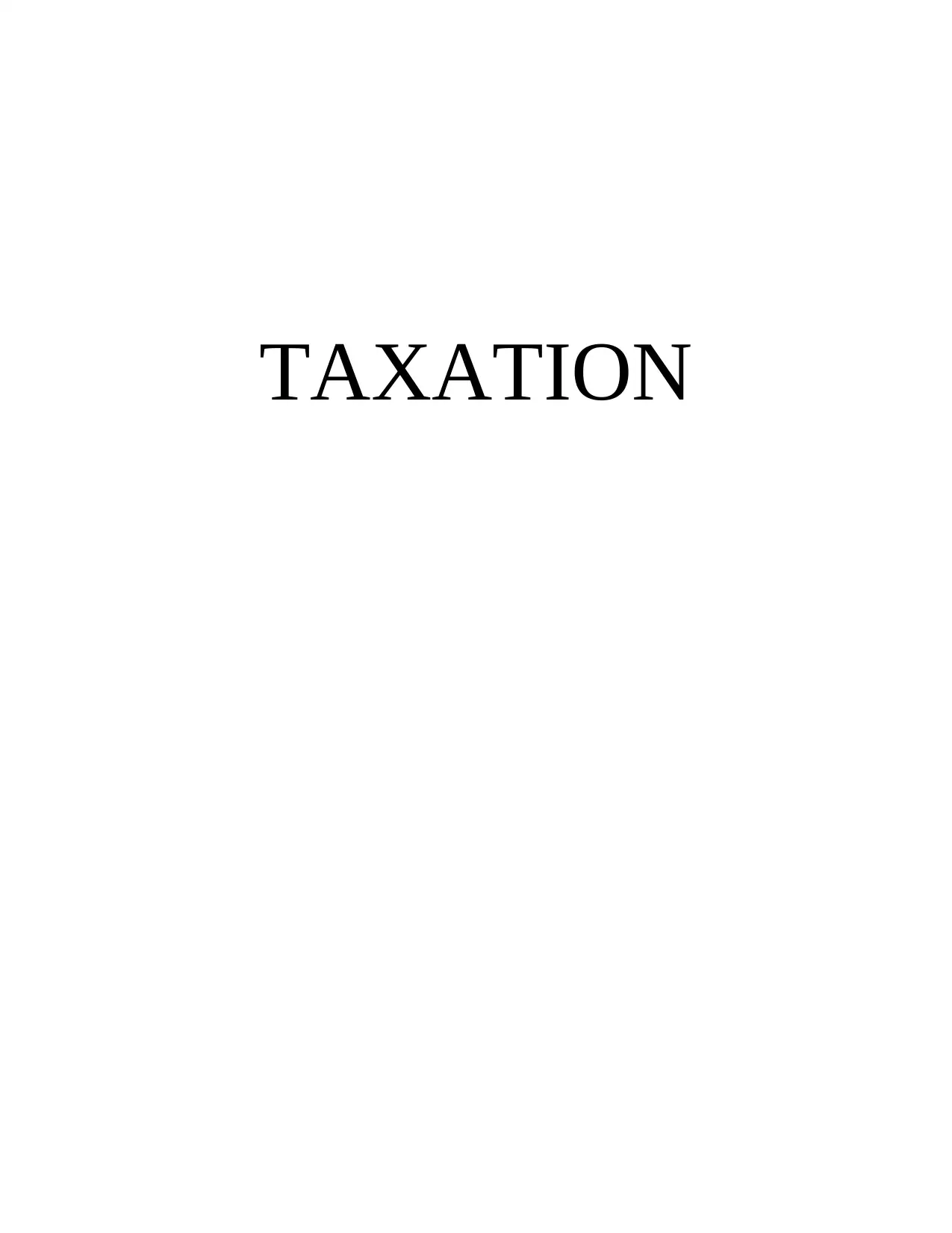
TAXATION
Secure Best Marks with AI Grader
Need help grading? Try our AI Grader for instant feedback on your assignments.
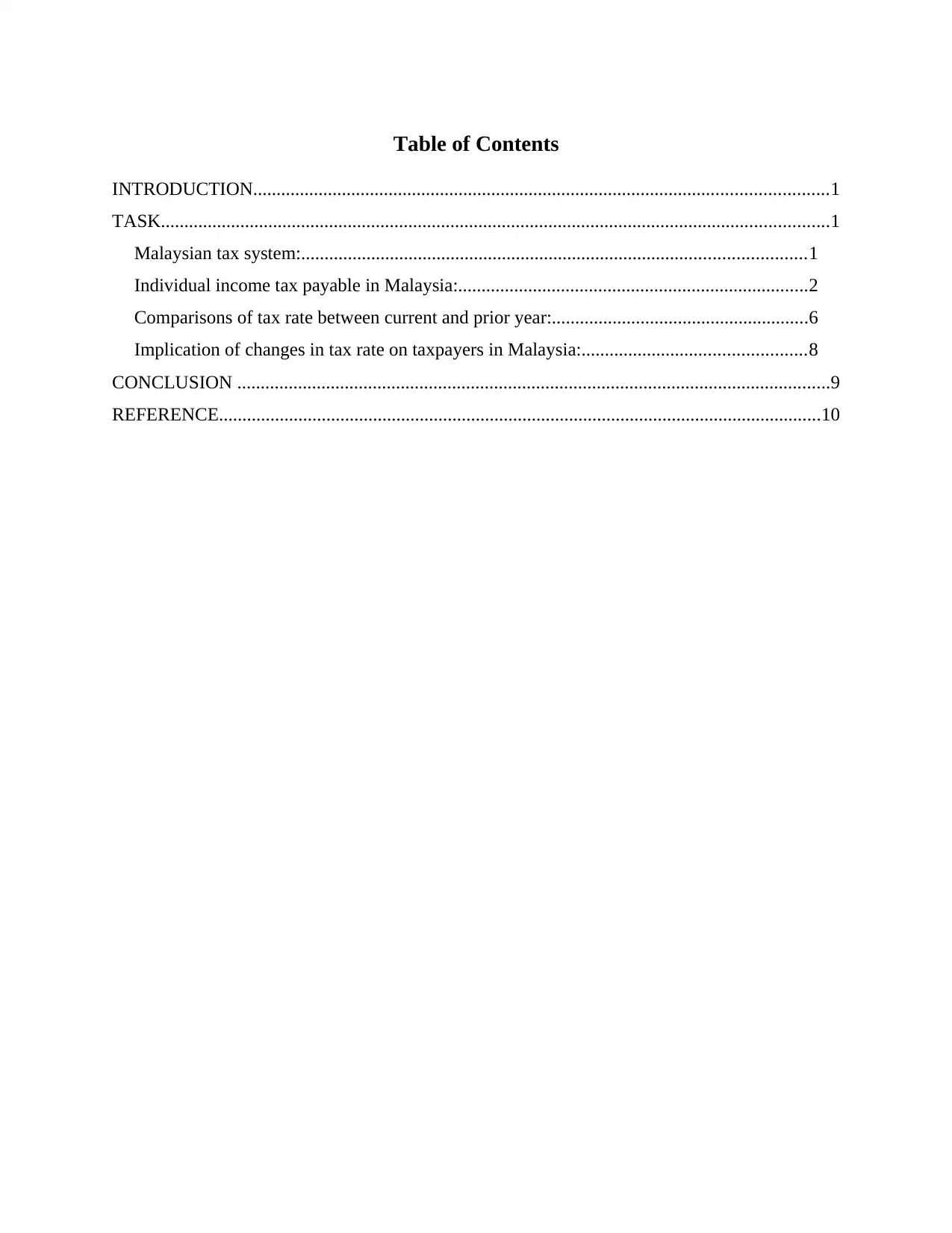
Table of Contents
INTRODUCTION...........................................................................................................................1
TASK...............................................................................................................................................1
Malaysian tax system:............................................................................................................1
Individual income tax payable in Malaysia:...........................................................................2
Comparisons of tax rate between current and prior year:.......................................................6
Implication of changes in tax rate on taxpayers in Malaysia:................................................8
CONCLUSION ...............................................................................................................................9
REFERENCE.................................................................................................................................10
INTRODUCTION...........................................................................................................................1
TASK...............................................................................................................................................1
Malaysian tax system:............................................................................................................1
Individual income tax payable in Malaysia:...........................................................................2
Comparisons of tax rate between current and prior year:.......................................................6
Implication of changes in tax rate on taxpayers in Malaysia:................................................8
CONCLUSION ...............................................................................................................................9
REFERENCE.................................................................................................................................10
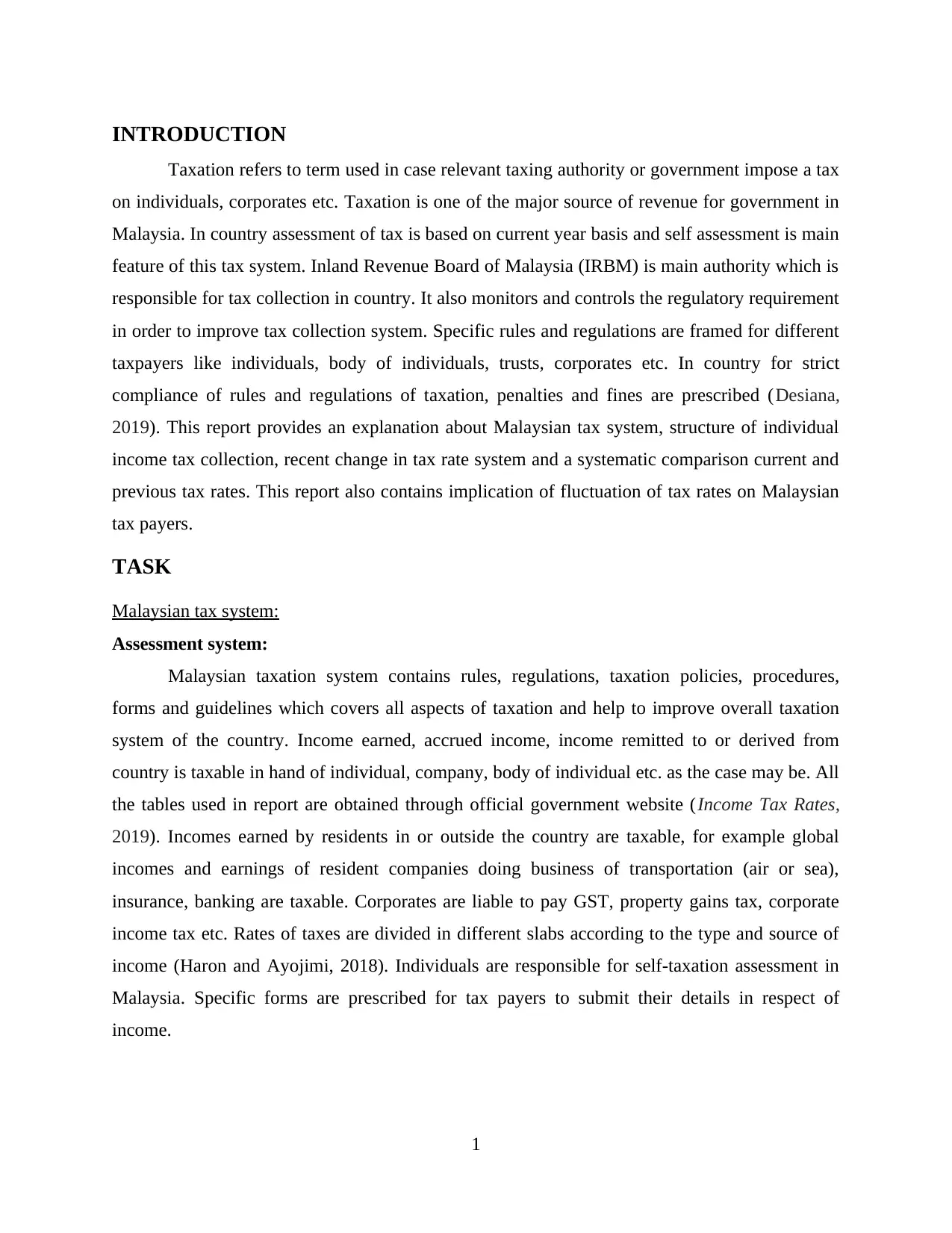
INTRODUCTION
Taxation refers to term used in case relevant taxing authority or government impose a tax
on individuals, corporates etc. Taxation is one of the major source of revenue for government in
Malaysia. In country assessment of tax is based on current year basis and self assessment is main
feature of this tax system. Inland Revenue Board of Malaysia (IRBM) is main authority which is
responsible for tax collection in country. It also monitors and controls the regulatory requirement
in order to improve tax collection system. Specific rules and regulations are framed for different
taxpayers like individuals, body of individuals, trusts, corporates etc. In country for strict
compliance of rules and regulations of taxation, penalties and fines are prescribed (Desiana,
2019). This report provides an explanation about Malaysian tax system, structure of individual
income tax collection, recent change in tax rate system and a systematic comparison current and
previous tax rates. This report also contains implication of fluctuation of tax rates on Malaysian
tax payers.
TASK
Malaysian tax system:
Assessment system:
Malaysian taxation system contains rules, regulations, taxation policies, procedures,
forms and guidelines which covers all aspects of taxation and help to improve overall taxation
system of the country. Income earned, accrued income, income remitted to or derived from
country is taxable in hand of individual, company, body of individual etc. as the case may be. All
the tables used in report are obtained through official government website (Income Tax Rates,
2019). Incomes earned by residents in or outside the country are taxable, for example global
incomes and earnings of resident companies doing business of transportation (air or sea),
insurance, banking are taxable. Corporates are liable to pay GST, property gains tax, corporate
income tax etc. Rates of taxes are divided in different slabs according to the type and source of
income (Haron and Ayojimi, 2018). Individuals are responsible for self-taxation assessment in
Malaysia. Specific forms are prescribed for tax payers to submit their details in respect of
income.
1
Taxation refers to term used in case relevant taxing authority or government impose a tax
on individuals, corporates etc. Taxation is one of the major source of revenue for government in
Malaysia. In country assessment of tax is based on current year basis and self assessment is main
feature of this tax system. Inland Revenue Board of Malaysia (IRBM) is main authority which is
responsible for tax collection in country. It also monitors and controls the regulatory requirement
in order to improve tax collection system. Specific rules and regulations are framed for different
taxpayers like individuals, body of individuals, trusts, corporates etc. In country for strict
compliance of rules and regulations of taxation, penalties and fines are prescribed (Desiana,
2019). This report provides an explanation about Malaysian tax system, structure of individual
income tax collection, recent change in tax rate system and a systematic comparison current and
previous tax rates. This report also contains implication of fluctuation of tax rates on Malaysian
tax payers.
TASK
Malaysian tax system:
Assessment system:
Malaysian taxation system contains rules, regulations, taxation policies, procedures,
forms and guidelines which covers all aspects of taxation and help to improve overall taxation
system of the country. Income earned, accrued income, income remitted to or derived from
country is taxable in hand of individual, company, body of individual etc. as the case may be. All
the tables used in report are obtained through official government website (Income Tax Rates,
2019). Incomes earned by residents in or outside the country are taxable, for example global
incomes and earnings of resident companies doing business of transportation (air or sea),
insurance, banking are taxable. Corporates are liable to pay GST, property gains tax, corporate
income tax etc. Rates of taxes are divided in different slabs according to the type and source of
income (Haron and Ayojimi, 2018). Individuals are responsible for self-taxation assessment in
Malaysia. Specific forms are prescribed for tax payers to submit their details in respect of
income.
1
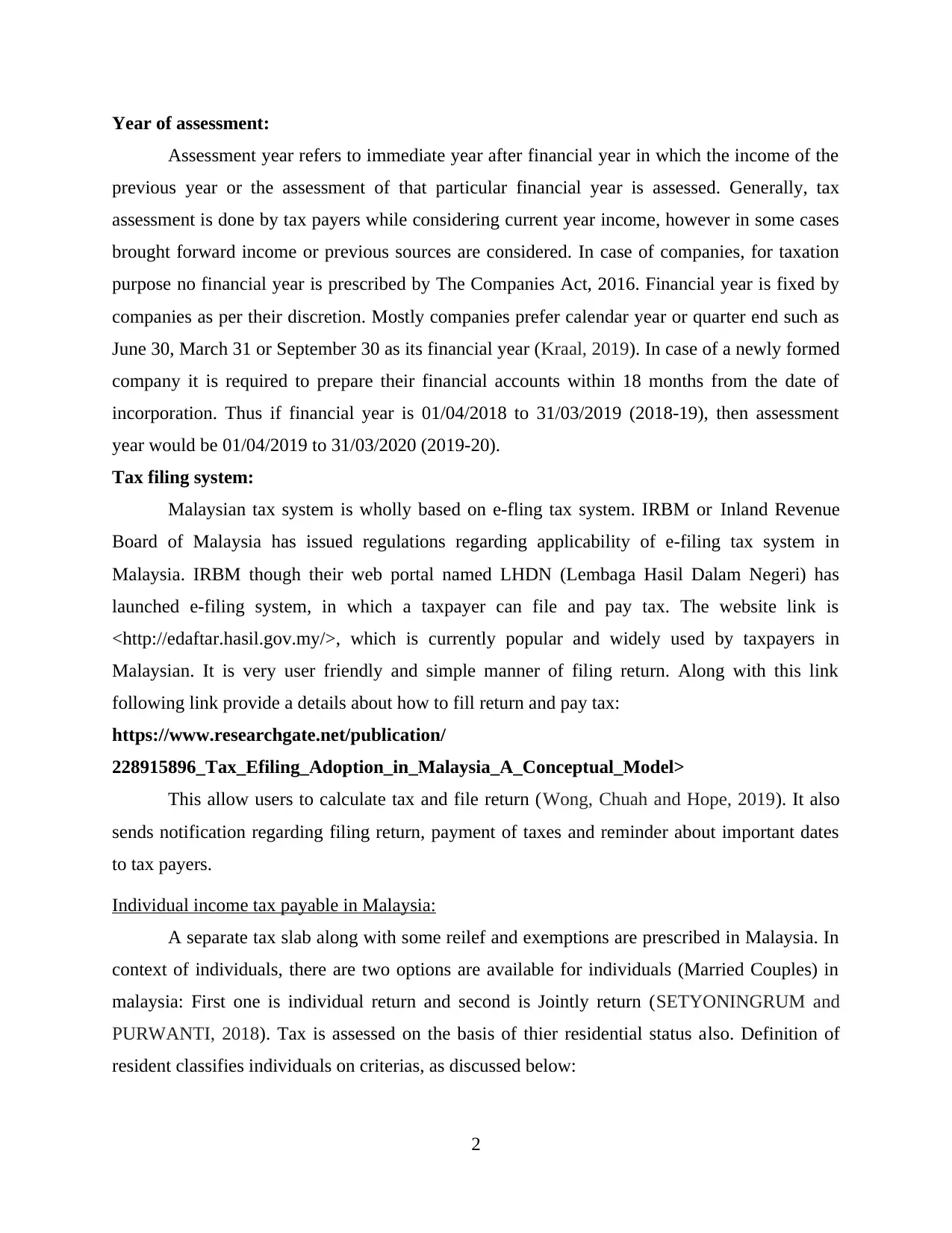
Year of assessment:
Assessment year refers to immediate year after financial year in which the income of the
previous year or the assessment of that particular financial year is assessed. Generally, tax
assessment is done by tax payers while considering current year income, however in some cases
brought forward income or previous sources are considered. In case of companies, for taxation
purpose no financial year is prescribed by The Companies Act, 2016. Financial year is fixed by
companies as per their discretion. Mostly companies prefer calendar year or quarter end such as
June 30, March 31 or September 30 as its financial year (Kraal, 2019). In case of a newly formed
company it is required to prepare their financial accounts within 18 months from the date of
incorporation. Thus if financial year is 01/04/2018 to 31/03/2019 (2018-19), then assessment
year would be 01/04/2019 to 31/03/2020 (2019-20).
Tax filing system:
Malaysian tax system is wholly based on e-fling tax system. IRBM or Inland Revenue
Board of Malaysia has issued regulations regarding applicability of e-filing tax system in
Malaysia. IRBM though their web portal named LHDN (Lembaga Hasil Dalam Negeri) has
launched e-filing system, in which a taxpayer can file and pay tax. The website link is
<http://edaftar.hasil.gov.my/>, which is currently popular and widely used by taxpayers in
Malaysian. It is very user friendly and simple manner of filing return. Along with this link
following link provide a details about how to fill return and pay tax:
https://www.researchgate.net/publication/
228915896_Tax_Efiling_Adoption_in_Malaysia_A_Conceptual_Model>
This allow users to calculate tax and file return (Wong, Chuah and Hope, 2019). It also
sends notification regarding filing return, payment of taxes and reminder about important dates
to tax payers.
Individual income tax payable in Malaysia:
A separate tax slab along with some reilef and exemptions are prescribed in Malaysia. In
context of individuals, there are two options are available for individuals (Married Couples) in
malaysia: First one is individual return and second is Jointly return (SETYONINGRUM and
PURWANTI, 2018). Tax is assessed on the basis of thier residential status also. Definition of
resident classifies individuals on criterias, as discussed below:
2
Assessment year refers to immediate year after financial year in which the income of the
previous year or the assessment of that particular financial year is assessed. Generally, tax
assessment is done by tax payers while considering current year income, however in some cases
brought forward income or previous sources are considered. In case of companies, for taxation
purpose no financial year is prescribed by The Companies Act, 2016. Financial year is fixed by
companies as per their discretion. Mostly companies prefer calendar year or quarter end such as
June 30, March 31 or September 30 as its financial year (Kraal, 2019). In case of a newly formed
company it is required to prepare their financial accounts within 18 months from the date of
incorporation. Thus if financial year is 01/04/2018 to 31/03/2019 (2018-19), then assessment
year would be 01/04/2019 to 31/03/2020 (2019-20).
Tax filing system:
Malaysian tax system is wholly based on e-fling tax system. IRBM or Inland Revenue
Board of Malaysia has issued regulations regarding applicability of e-filing tax system in
Malaysia. IRBM though their web portal named LHDN (Lembaga Hasil Dalam Negeri) has
launched e-filing system, in which a taxpayer can file and pay tax. The website link is
<http://edaftar.hasil.gov.my/>, which is currently popular and widely used by taxpayers in
Malaysian. It is very user friendly and simple manner of filing return. Along with this link
following link provide a details about how to fill return and pay tax:
https://www.researchgate.net/publication/
228915896_Tax_Efiling_Adoption_in_Malaysia_A_Conceptual_Model>
This allow users to calculate tax and file return (Wong, Chuah and Hope, 2019). It also
sends notification regarding filing return, payment of taxes and reminder about important dates
to tax payers.
Individual income tax payable in Malaysia:
A separate tax slab along with some reilef and exemptions are prescribed in Malaysia. In
context of individuals, there are two options are available for individuals (Married Couples) in
malaysia: First one is individual return and second is Jointly return (SETYONINGRUM and
PURWANTI, 2018). Tax is assessed on the basis of thier residential status also. Definition of
resident classifies individuals on criterias, as discussed below:
2
Secure Best Marks with AI Grader
Need help grading? Try our AI Grader for instant feedback on your assignments.
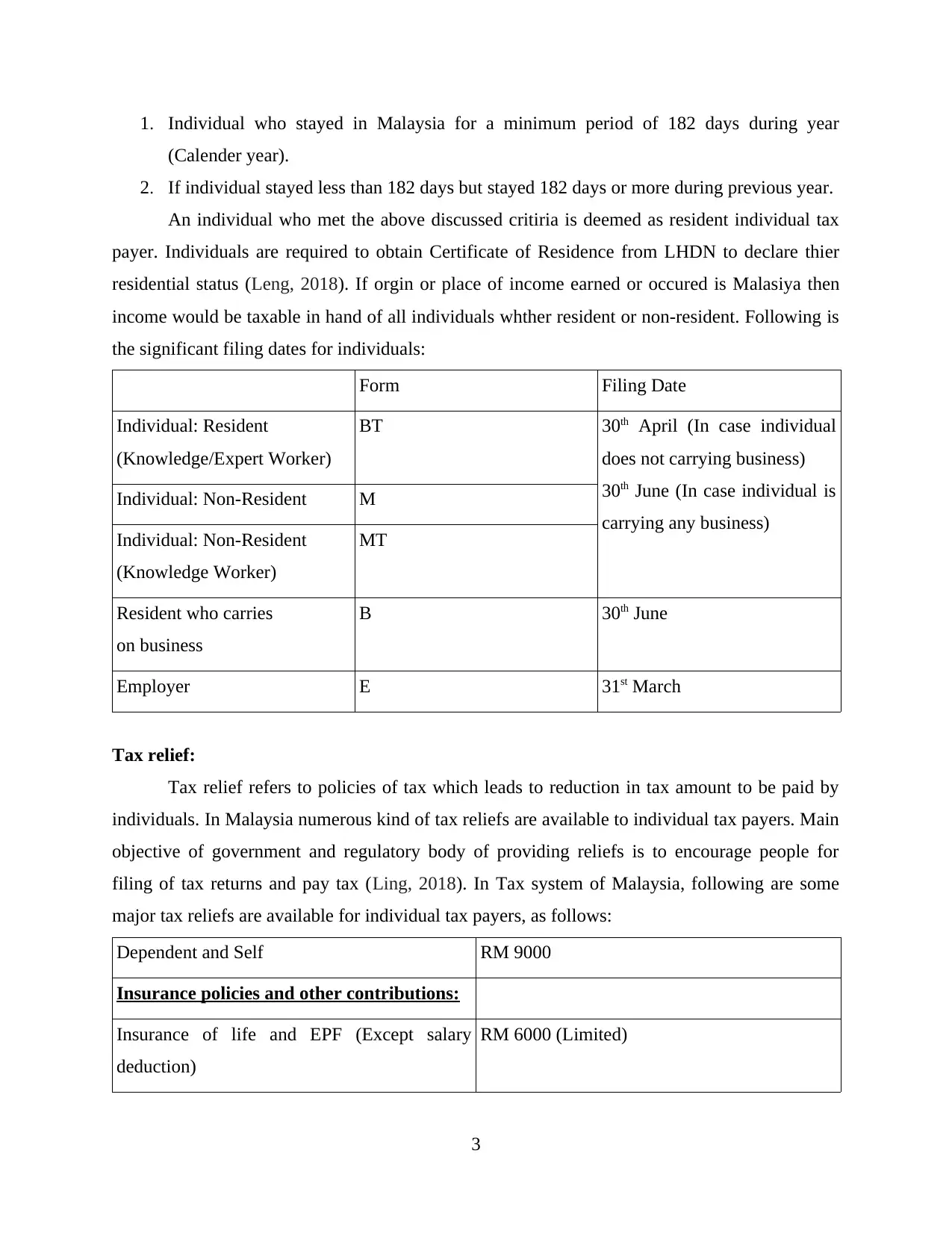
1. Individual who stayed in Malaysia for a minimum period of 182 days during year
(Calender year).
2. If individual stayed less than 182 days but stayed 182 days or more during previous year.
An individual who met the above discussed critiria is deemed as resident individual tax
payer. Individuals are required to obtain Certificate of Residence from LHDN to declare thier
residential status (Leng, 2018). If orgin or place of income earned or occured is Malasiya then
income would be taxable in hand of all individuals whther resident or non-resident. Following is
the significant filing dates for individuals:
Form Filing Date
Individual: Resident
(Knowledge/Expert Worker)
BT 30th April (In case individual
does not carrying business)
30th June (In case individual is
carrying any business)
Individual: Non-Resident M
Individual: Non-Resident
(Knowledge Worker)
MT
Resident who carries
on business
B 30th June
Employer E 31st March
Tax relief:
Tax relief refers to policies of tax which leads to reduction in tax amount to be paid by
individuals. In Malaysia numerous kind of tax reliefs are available to individual tax payers. Main
objective of government and regulatory body of providing reliefs is to encourage people for
filing of tax returns and pay tax (Ling, 2018). In Tax system of Malaysia, following are some
major tax reliefs are available for individual tax payers, as follows:
Dependent and Self RM 9000
Insurance policies and other contributions:
Insurance of life and EPF (Except salary
deduction)
RM 6000 (Limited)
3
(Calender year).
2. If individual stayed less than 182 days but stayed 182 days or more during previous year.
An individual who met the above discussed critiria is deemed as resident individual tax
payer. Individuals are required to obtain Certificate of Residence from LHDN to declare thier
residential status (Leng, 2018). If orgin or place of income earned or occured is Malasiya then
income would be taxable in hand of all individuals whther resident or non-resident. Following is
the significant filing dates for individuals:
Form Filing Date
Individual: Resident
(Knowledge/Expert Worker)
BT 30th April (In case individual
does not carrying business)
30th June (In case individual is
carrying any business)
Individual: Non-Resident M
Individual: Non-Resident
(Knowledge Worker)
MT
Resident who carries
on business
B 30th June
Employer E 31st March
Tax relief:
Tax relief refers to policies of tax which leads to reduction in tax amount to be paid by
individuals. In Malaysia numerous kind of tax reliefs are available to individual tax payers. Main
objective of government and regulatory body of providing reliefs is to encourage people for
filing of tax returns and pay tax (Ling, 2018). In Tax system of Malaysia, following are some
major tax reliefs are available for individual tax payers, as follows:
Dependent and Self RM 9000
Insurance policies and other contributions:
Insurance of life and EPF (Except salary
deduction)
RM 6000 (Limited)
3
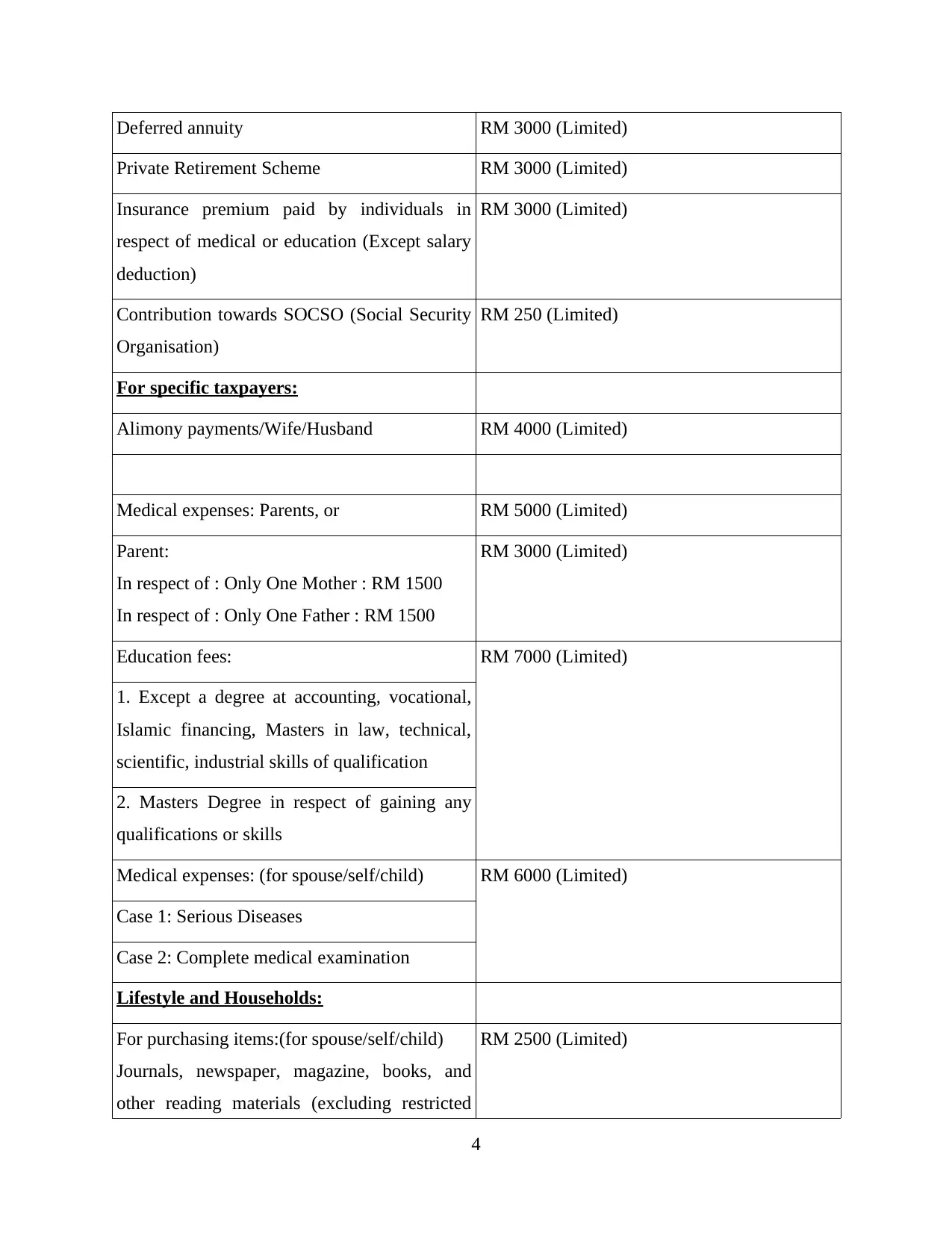
Deferred annuity RM 3000 (Limited)
Private Retirement Scheme RM 3000 (Limited)
Insurance premium paid by individuals in
respect of medical or education (Except salary
deduction)
RM 3000 (Limited)
Contribution towards SOCSO (Social Security
Organisation)
RM 250 (Limited)
For specific taxpayers:
Alimony payments/Wife/Husband RM 4000 (Limited)
Medical expenses: Parents, or RM 5000 (Limited)
Parent:
In respect of : Only One Mother : RM 1500
In respect of : Only One Father : RM 1500
RM 3000 (Limited)
Education fees: RM 7000 (Limited)
1. Except a degree at accounting, vocational,
Islamic financing, Masters in law, technical,
scientific, industrial skills of qualification
2. Masters Degree in respect of gaining any
qualifications or skills
Medical expenses: (for spouse/self/child) RM 6000 (Limited)
Case 1: Serious Diseases
Case 2: Complete medical examination
Lifestyle and Households:
For purchasing items:(for spouse/self/child)
Journals, newspaper, magazine, books, and
other reading materials (excluding restricted
RM 2500 (Limited)
4
Private Retirement Scheme RM 3000 (Limited)
Insurance premium paid by individuals in
respect of medical or education (Except salary
deduction)
RM 3000 (Limited)
Contribution towards SOCSO (Social Security
Organisation)
RM 250 (Limited)
For specific taxpayers:
Alimony payments/Wife/Husband RM 4000 (Limited)
Medical expenses: Parents, or RM 5000 (Limited)
Parent:
In respect of : Only One Mother : RM 1500
In respect of : Only One Father : RM 1500
RM 3000 (Limited)
Education fees: RM 7000 (Limited)
1. Except a degree at accounting, vocational,
Islamic financing, Masters in law, technical,
scientific, industrial skills of qualification
2. Masters Degree in respect of gaining any
qualifications or skills
Medical expenses: (for spouse/self/child) RM 6000 (Limited)
Case 1: Serious Diseases
Case 2: Complete medical examination
Lifestyle and Households:
For purchasing items:(for spouse/self/child)
Journals, newspaper, magazine, books, and
other reading materials (excluding restricted
RM 2500 (Limited)
4
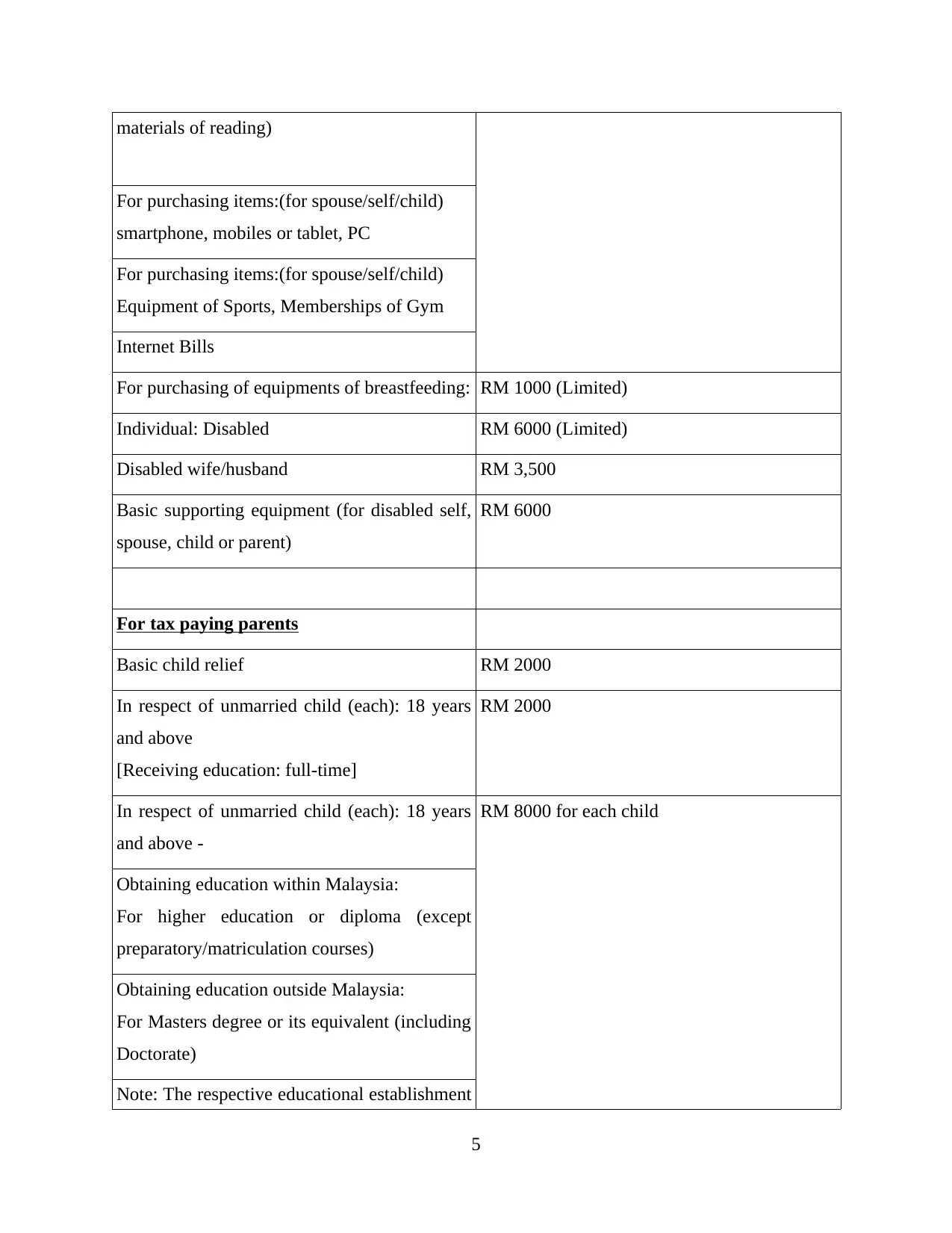
materials of reading)
For purchasing items:(for spouse/self/child)
smartphone, mobiles or tablet, PC
For purchasing items:(for spouse/self/child)
Equipment of Sports, Memberships of Gym
Internet Bills
For purchasing of equipments of breastfeeding: RM 1000 (Limited)
Individual: Disabled RM 6000 (Limited)
Disabled wife/husband RM 3,500
Basic supporting equipment (for disabled self,
spouse, child or parent)
RM 6000
For tax paying parents
Basic child relief RM 2000
In respect of unmarried child (each): 18 years
and above
[Receiving education: full-time]
RM 2000
In respect of unmarried child (each): 18 years
and above -
RM 8000 for each child
Obtaining education within Malaysia:
For higher education or diploma (except
preparatory/matriculation courses)
Obtaining education outside Malaysia:
For Masters degree or its equivalent (including
Doctorate)
Note: The respective educational establishment
5
For purchasing items:(for spouse/self/child)
smartphone, mobiles or tablet, PC
For purchasing items:(for spouse/self/child)
Equipment of Sports, Memberships of Gym
Internet Bills
For purchasing of equipments of breastfeeding: RM 1000 (Limited)
Individual: Disabled RM 6000 (Limited)
Disabled wife/husband RM 3,500
Basic supporting equipment (for disabled self,
spouse, child or parent)
RM 6000
For tax paying parents
Basic child relief RM 2000
In respect of unmarried child (each): 18 years
and above
[Receiving education: full-time]
RM 2000
In respect of unmarried child (each): 18 years
and above -
RM 8000 for each child
Obtaining education within Malaysia:
For higher education or diploma (except
preparatory/matriculation courses)
Obtaining education outside Malaysia:
For Masters degree or its equivalent (including
Doctorate)
Note: The respective educational establishment
5
Paraphrase This Document
Need a fresh take? Get an instant paraphrase of this document with our AI Paraphraser
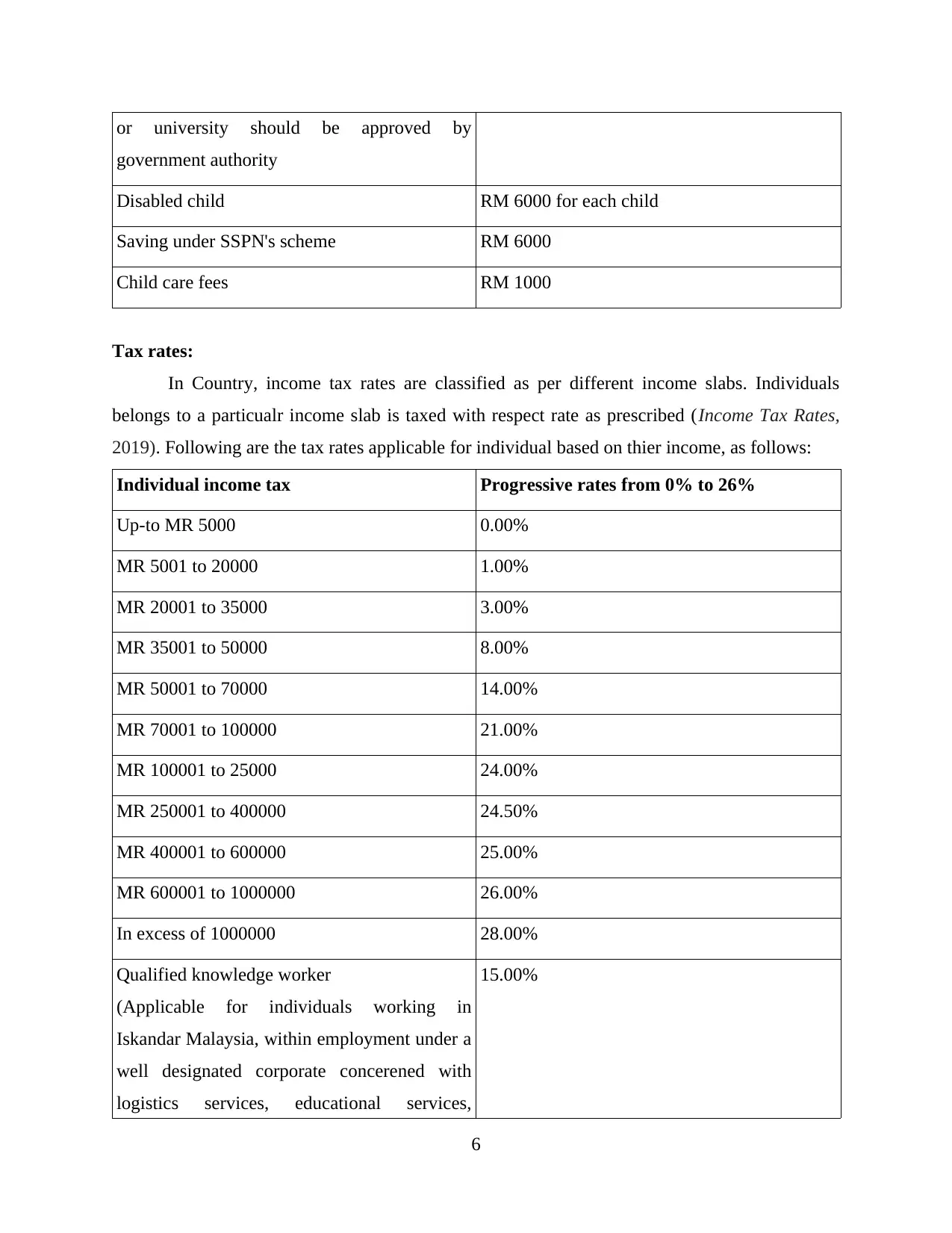
or university should be approved by
government authority
Disabled child RM 6000 for each child
Saving under SSPN's scheme RM 6000
Child care fees RM 1000
Tax rates:
In Country, income tax rates are classified as per different income slabs. Individuals
belongs to a particualr income slab is taxed with respect rate as prescribed (Income Tax Rates,
2019). Following are the tax rates applicable for individual based on thier income, as follows:
Individual income tax Progressive rates from 0% to 26%
Up-to MR 5000 0.00%
MR 5001 to 20000 1.00%
MR 20001 to 35000 3.00%
MR 35001 to 50000 8.00%
MR 50001 to 70000 14.00%
MR 70001 to 100000 21.00%
MR 100001 to 25000 24.00%
MR 250001 to 400000 24.50%
MR 400001 to 600000 25.00%
MR 600001 to 1000000 26.00%
In excess of 1000000 28.00%
Qualified knowledge worker
(Applicable for individuals working in
Iskandar Malaysia, within employment under a
well designated corporate concerened with
logistics services, educational services,
15.00%
6
government authority
Disabled child RM 6000 for each child
Saving under SSPN's scheme RM 6000
Child care fees RM 1000
Tax rates:
In Country, income tax rates are classified as per different income slabs. Individuals
belongs to a particualr income slab is taxed with respect rate as prescribed (Income Tax Rates,
2019). Following are the tax rates applicable for individual based on thier income, as follows:
Individual income tax Progressive rates from 0% to 26%
Up-to MR 5000 0.00%
MR 5001 to 20000 1.00%
MR 20001 to 35000 3.00%
MR 35001 to 50000 8.00%
MR 50001 to 70000 14.00%
MR 70001 to 100000 21.00%
MR 100001 to 25000 24.00%
MR 250001 to 400000 24.50%
MR 400001 to 600000 25.00%
MR 600001 to 1000000 26.00%
In excess of 1000000 28.00%
Qualified knowledge worker
(Applicable for individuals working in
Iskandar Malaysia, within employment under a
well designated corporate concerened with
logistics services, educational services,
15.00%
6
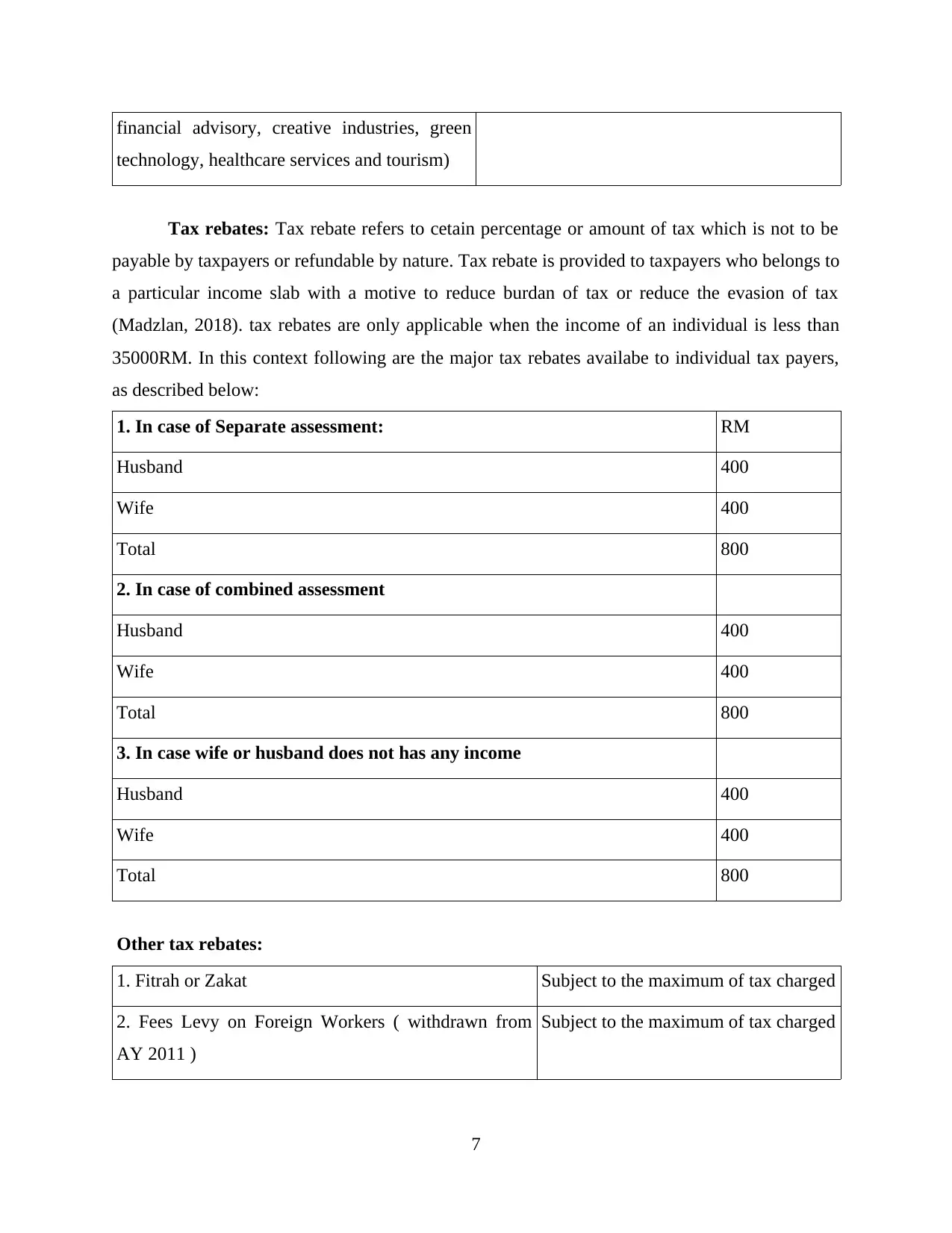
financial advisory, creative industries, green
technology, healthcare services and tourism)
Tax rebates: Tax rebate refers to cetain percentage or amount of tax which is not to be
payable by taxpayers or refundable by nature. Tax rebate is provided to taxpayers who belongs to
a particular income slab with a motive to reduce burdan of tax or reduce the evasion of tax
(Madzlan, 2018). tax rebates are only applicable when the income of an individual is less than
35000RM. In this context following are the major tax rebates availabe to individual tax payers,
as described below:
1. In case of Separate assessment: RM
Husband 400
Wife 400
Total 800
2. In case of combined assessment
Husband 400
Wife 400
Total 800
3. In case wife or husband does not has any income
Husband 400
Wife 400
Total 800
Other tax rebates:
1. Fitrah or Zakat Subject to the maximum of tax charged
2. Fees Levy on Foreign Workers ( withdrawn from
AY 2011 )
Subject to the maximum of tax charged
7
technology, healthcare services and tourism)
Tax rebates: Tax rebate refers to cetain percentage or amount of tax which is not to be
payable by taxpayers or refundable by nature. Tax rebate is provided to taxpayers who belongs to
a particular income slab with a motive to reduce burdan of tax or reduce the evasion of tax
(Madzlan, 2018). tax rebates are only applicable when the income of an individual is less than
35000RM. In this context following are the major tax rebates availabe to individual tax payers,
as described below:
1. In case of Separate assessment: RM
Husband 400
Wife 400
Total 800
2. In case of combined assessment
Husband 400
Wife 400
Total 800
3. In case wife or husband does not has any income
Husband 400
Wife 400
Total 800
Other tax rebates:
1. Fitrah or Zakat Subject to the maximum of tax charged
2. Fees Levy on Foreign Workers ( withdrawn from
AY 2011 )
Subject to the maximum of tax charged
7
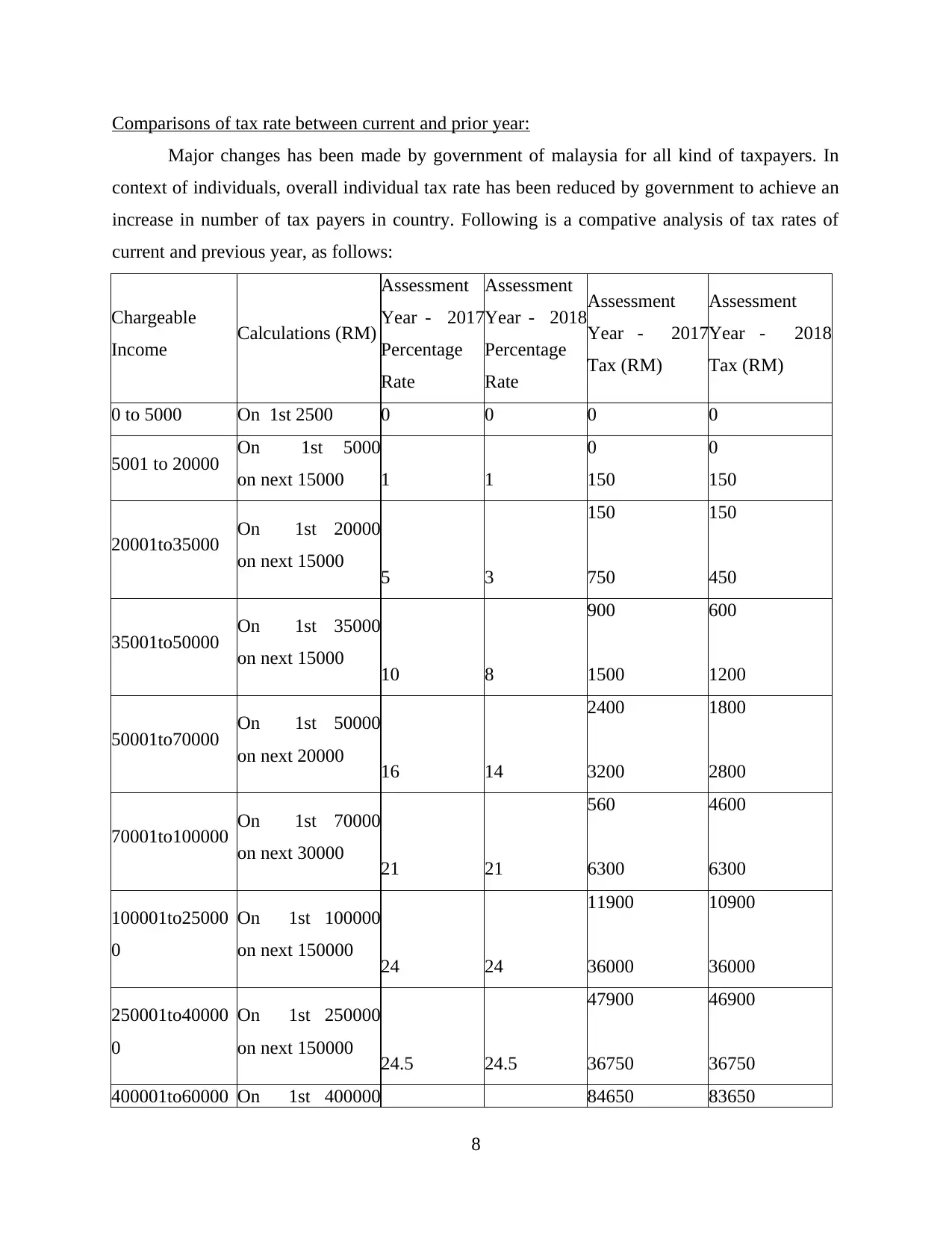
Comparisons of tax rate between current and prior year:
Major changes has been made by government of malaysia for all kind of taxpayers. In
context of individuals, overall individual tax rate has been reduced by government to achieve an
increase in number of tax payers in country. Following is a compative analysis of tax rates of
current and previous year, as follows:
Chargeable
Income Calculations (RM)
Assessment
Year - 2017
Percentage
Rate
Assessment
Year - 2018
Percentage
Rate
Assessment
Year - 2017
Tax (RM)
Assessment
Year - 2018
Tax (RM)
0 to 5000 On 1st 2500 0 0 0 0
5001 to 20000 On 1st 5000
on next 15000 1 1
0
150
0
150
20001to35000 On 1st 20000
on next 15000 5 3
150
750
150
450
35001to50000 On 1st 35000
on next 15000 10 8
900
1500
600
1200
50001to70000 On 1st 50000
on next 20000 16 14
2400
3200
1800
2800
70001to100000 On 1st 70000
on next 30000 21 21
560
6300
4600
6300
100001to25000
0
On 1st 100000
on next 150000 24 24
11900
36000
10900
36000
250001to40000
0
On 1st 250000
on next 150000 24.5 24.5
47900
36750
46900
36750
400001to60000 On 1st 400000 84650 83650
8
Major changes has been made by government of malaysia for all kind of taxpayers. In
context of individuals, overall individual tax rate has been reduced by government to achieve an
increase in number of tax payers in country. Following is a compative analysis of tax rates of
current and previous year, as follows:
Chargeable
Income Calculations (RM)
Assessment
Year - 2017
Percentage
Rate
Assessment
Year - 2018
Percentage
Rate
Assessment
Year - 2017
Tax (RM)
Assessment
Year - 2018
Tax (RM)
0 to 5000 On 1st 2500 0 0 0 0
5001 to 20000 On 1st 5000
on next 15000 1 1
0
150
0
150
20001to35000 On 1st 20000
on next 15000 5 3
150
750
150
450
35001to50000 On 1st 35000
on next 15000 10 8
900
1500
600
1200
50001to70000 On 1st 50000
on next 20000 16 14
2400
3200
1800
2800
70001to100000 On 1st 70000
on next 30000 21 21
560
6300
4600
6300
100001to25000
0
On 1st 100000
on next 150000 24 24
11900
36000
10900
36000
250001to40000
0
On 1st 250000
on next 150000 24.5 24.5
47900
36750
46900
36750
400001to60000 On 1st 400000 84650 83650
8
Secure Best Marks with AI Grader
Need help grading? Try our AI Grader for instant feedback on your assignments.
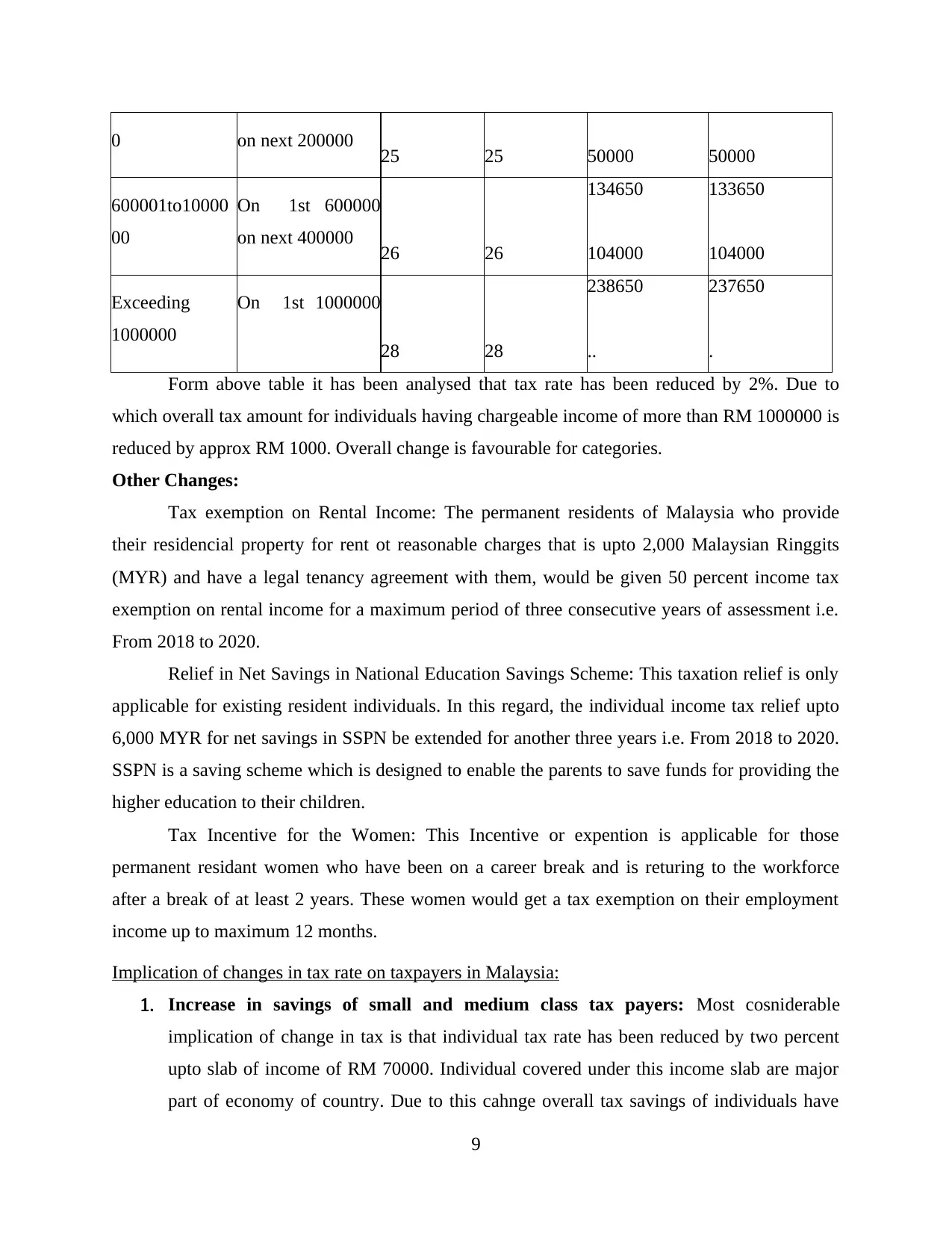
0 on next 200000 25 25 50000 50000
600001to10000
00
On 1st 600000
on next 400000 26 26
134650
104000
133650
104000
Exceeding
1000000
On 1st 1000000
28 28
238650
..
237650
.
Form above table it has been analysed that tax rate has been reduced by 2%. Due to
which overall tax amount for individuals having chargeable income of more than RM 1000000 is
reduced by approx RM 1000. Overall change is favourable for categories.
Other Changes:
Tax exemption on Rental Income: The permanent residents of Malaysia who provide
their residencial property for rent ot reasonable charges that is upto 2,000 Malaysian Ringgits
(MYR) and have a legal tenancy agreement with them, would be given 50 percent income tax
exemption on rental income for a maximum period of three consecutive years of assessment i.e.
From 2018 to 2020.
Relief in Net Savings in National Education Savings Scheme: This taxation relief is only
applicable for existing resident individuals. In this regard, the individual income tax relief upto
6,000 MYR for net savings in SSPN be extended for another three years i.e. From 2018 to 2020.
SSPN is a saving scheme which is designed to enable the parents to save funds for providing the
higher education to their children.
Tax Incentive for the Women: This Incentive or expention is applicable for those
permanent residant women who have been on a career break and is returing to the workforce
after a break of at least 2 years. These women would get a tax exemption on their employment
income up to maximum 12 months.
Implication of changes in tax rate on taxpayers in Malaysia:
1. Increase in savings of small and medium class tax payers: Most cosniderable
implication of change in tax is that individual tax rate has been reduced by two percent
upto slab of income of RM 70000. Individual covered under this income slab are major
part of economy of country. Due to this cahnge overall tax savings of individuals have
9
600001to10000
00
On 1st 600000
on next 400000 26 26
134650
104000
133650
104000
Exceeding
1000000
On 1st 1000000
28 28
238650
..
237650
.
Form above table it has been analysed that tax rate has been reduced by 2%. Due to
which overall tax amount for individuals having chargeable income of more than RM 1000000 is
reduced by approx RM 1000. Overall change is favourable for categories.
Other Changes:
Tax exemption on Rental Income: The permanent residents of Malaysia who provide
their residencial property for rent ot reasonable charges that is upto 2,000 Malaysian Ringgits
(MYR) and have a legal tenancy agreement with them, would be given 50 percent income tax
exemption on rental income for a maximum period of three consecutive years of assessment i.e.
From 2018 to 2020.
Relief in Net Savings in National Education Savings Scheme: This taxation relief is only
applicable for existing resident individuals. In this regard, the individual income tax relief upto
6,000 MYR for net savings in SSPN be extended for another three years i.e. From 2018 to 2020.
SSPN is a saving scheme which is designed to enable the parents to save funds for providing the
higher education to their children.
Tax Incentive for the Women: This Incentive or expention is applicable for those
permanent residant women who have been on a career break and is returing to the workforce
after a break of at least 2 years. These women would get a tax exemption on their employment
income up to maximum 12 months.
Implication of changes in tax rate on taxpayers in Malaysia:
1. Increase in savings of small and medium class tax payers: Most cosniderable
implication of change in tax is that individual tax rate has been reduced by two percent
upto slab of income of RM 70000. Individual covered under this income slab are major
part of economy of country. Due to this cahnge overall tax savings of individuals have
9
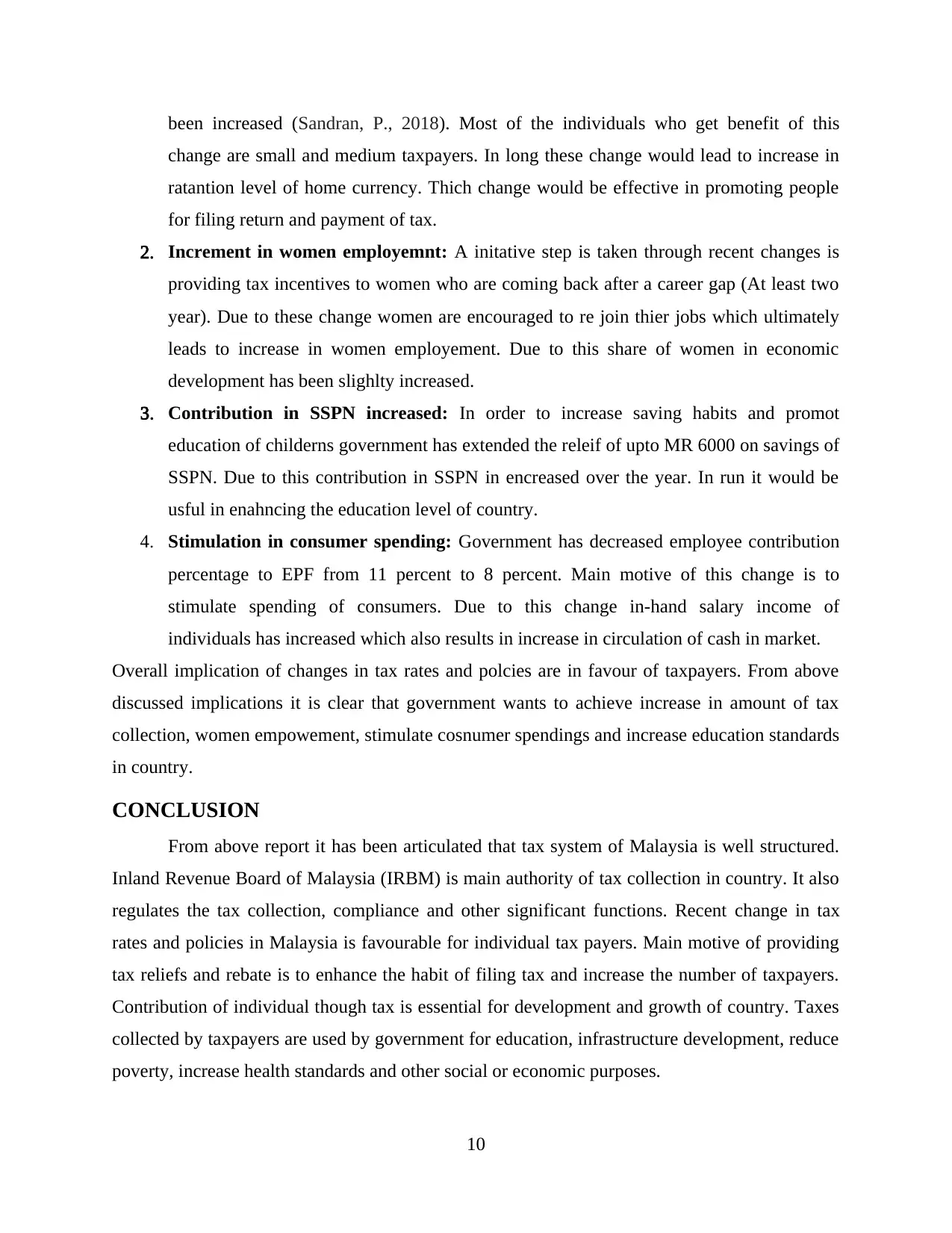
been increased (Sandran, P., 2018). Most of the individuals who get benefit of this
change are small and medium taxpayers. In long these change would lead to increase in
ratantion level of home currency. Thich change would be effective in promoting people
for filing return and payment of tax.
2. Increment in women employemnt: A initative step is taken through recent changes is
providing tax incentives to women who are coming back after a career gap (At least two
year). Due to these change women are encouraged to re join thier jobs which ultimately
leads to increase in women employement. Due to this share of women in economic
development has been slighlty increased.
3. Contribution in SSPN increased: In order to increase saving habits and promot
education of childerns government has extended the releif of upto MR 6000 on savings of
SSPN. Due to this contribution in SSPN in encreased over the year. In run it would be
usful in enahncing the education level of country.
4. Stimulation in consumer spending: Government has decreased employee contribution
percentage to EPF from 11 percent to 8 percent. Main motive of this change is to
stimulate spending of consumers. Due to this change in-hand salary income of
individuals has increased which also results in increase in circulation of cash in market.
Overall implication of changes in tax rates and polcies are in favour of taxpayers. From above
discussed implications it is clear that government wants to achieve increase in amount of tax
collection, women empowement, stimulate cosnumer spendings and increase education standards
in country.
CONCLUSION
From above report it has been articulated that tax system of Malaysia is well structured.
Inland Revenue Board of Malaysia (IRBM) is main authority of tax collection in country. It also
regulates the tax collection, compliance and other significant functions. Recent change in tax
rates and policies in Malaysia is favourable for individual tax payers. Main motive of providing
tax reliefs and rebate is to enhance the habit of filing tax and increase the number of taxpayers.
Contribution of individual though tax is essential for development and growth of country. Taxes
collected by taxpayers are used by government for education, infrastructure development, reduce
poverty, increase health standards and other social or economic purposes.
10
change are small and medium taxpayers. In long these change would lead to increase in
ratantion level of home currency. Thich change would be effective in promoting people
for filing return and payment of tax.
2. Increment in women employemnt: A initative step is taken through recent changes is
providing tax incentives to women who are coming back after a career gap (At least two
year). Due to these change women are encouraged to re join thier jobs which ultimately
leads to increase in women employement. Due to this share of women in economic
development has been slighlty increased.
3. Contribution in SSPN increased: In order to increase saving habits and promot
education of childerns government has extended the releif of upto MR 6000 on savings of
SSPN. Due to this contribution in SSPN in encreased over the year. In run it would be
usful in enahncing the education level of country.
4. Stimulation in consumer spending: Government has decreased employee contribution
percentage to EPF from 11 percent to 8 percent. Main motive of this change is to
stimulate spending of consumers. Due to this change in-hand salary income of
individuals has increased which also results in increase in circulation of cash in market.
Overall implication of changes in tax rates and polcies are in favour of taxpayers. From above
discussed implications it is clear that government wants to achieve increase in amount of tax
collection, women empowement, stimulate cosnumer spendings and increase education standards
in country.
CONCLUSION
From above report it has been articulated that tax system of Malaysia is well structured.
Inland Revenue Board of Malaysia (IRBM) is main authority of tax collection in country. It also
regulates the tax collection, compliance and other significant functions. Recent change in tax
rates and policies in Malaysia is favourable for individual tax payers. Main motive of providing
tax reliefs and rebate is to enhance the habit of filing tax and increase the number of taxpayers.
Contribution of individual though tax is essential for development and growth of country. Taxes
collected by taxpayers are used by government for education, infrastructure development, reduce
poverty, increase health standards and other social or economic purposes.
10
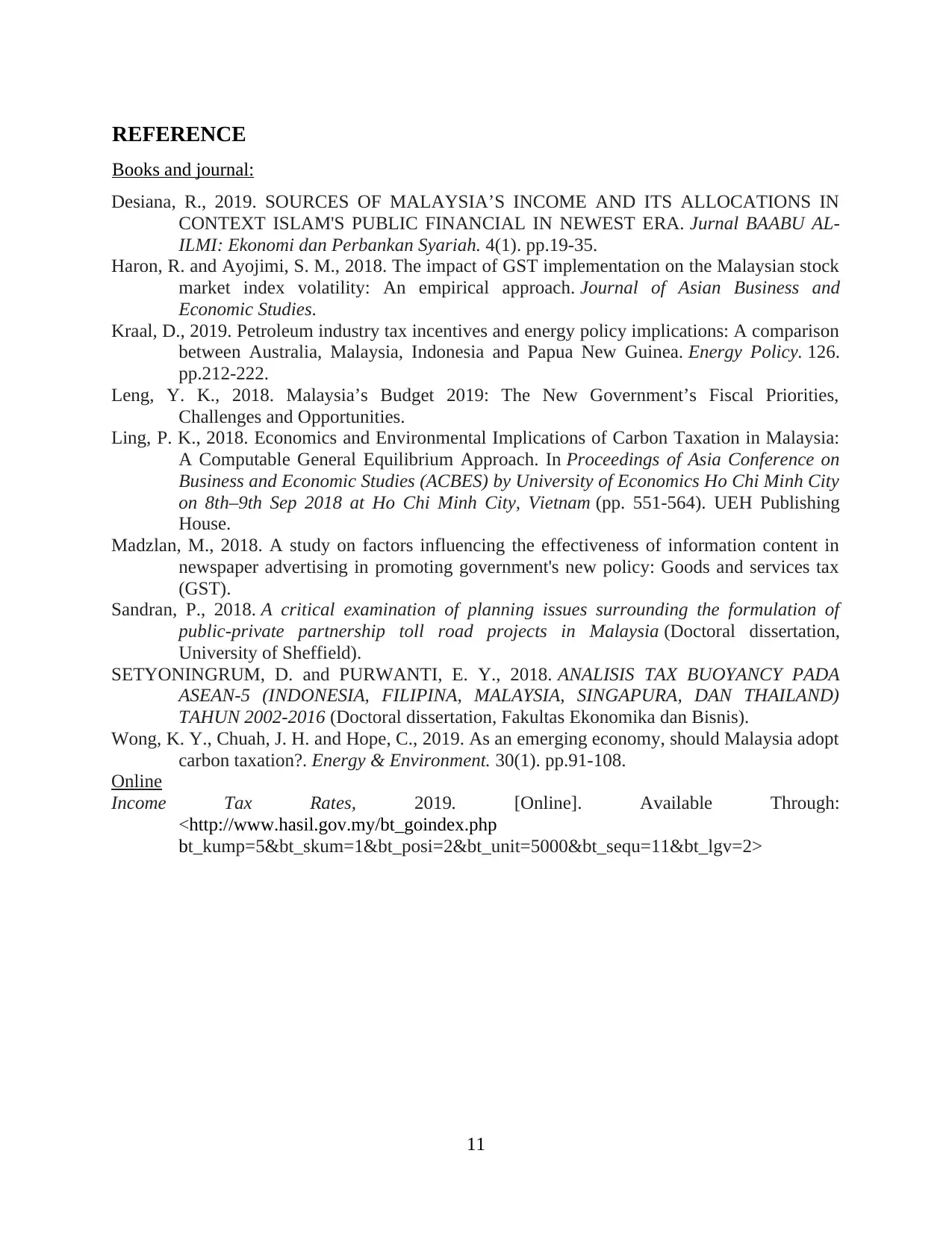
REFERENCE
Books and journal:
Desiana, R., 2019. SOURCES OF MALAYSIA’S INCOME AND ITS ALLOCATIONS IN
CONTEXT ISLAM'S PUBLIC FINANCIAL IN NEWEST ERA. Jurnal BAABU AL-
ILMI: Ekonomi dan Perbankan Syariah. 4(1). pp.19-35.
Haron, R. and Ayojimi, S. M., 2018. The impact of GST implementation on the Malaysian stock
market index volatility: An empirical approach. Journal of Asian Business and
Economic Studies.
Kraal, D., 2019. Petroleum industry tax incentives and energy policy implications: A comparison
between Australia, Malaysia, Indonesia and Papua New Guinea. Energy Policy. 126.
pp.212-222.
Leng, Y. K., 2018. Malaysia’s Budget 2019: The New Government’s Fiscal Priorities,
Challenges and Opportunities.
Ling, P. K., 2018. Economics and Environmental Implications of Carbon Taxation in Malaysia:
A Computable General Equilibrium Approach. In Proceedings of Asia Conference on
Business and Economic Studies (ACBES) by University of Economics Ho Chi Minh City
on 8th–9th Sep 2018 at Ho Chi Minh City, Vietnam (pp. 551-564). UEH Publishing
House.
Madzlan, M., 2018. A study on factors influencing the effectiveness of information content in
newspaper advertising in promoting government's new policy: Goods and services tax
(GST).
Sandran, P., 2018. A critical examination of planning issues surrounding the formulation of
public-private partnership toll road projects in Malaysia (Doctoral dissertation,
University of Sheffield).
SETYONINGRUM, D. and PURWANTI, E. Y., 2018. ANALISIS TAX BUOYANCY PADA
ASEAN-5 (INDONESIA, FILIPINA, MALAYSIA, SINGAPURA, DAN THAILAND)
TAHUN 2002-2016 (Doctoral dissertation, Fakultas Ekonomika dan Bisnis).
Wong, K. Y., Chuah, J. H. and Hope, C., 2019. As an emerging economy, should Malaysia adopt
carbon taxation?. Energy & Environment. 30(1). pp.91-108.
Online
Income Tax Rates, 2019. [Online]. Available Through:
<http://www.hasil.gov.my/bt_goindex.php
bt_kump=5&bt_skum=1&bt_posi=2&bt_unit=5000&bt_sequ=11&bt_lgv=2>
11
Books and journal:
Desiana, R., 2019. SOURCES OF MALAYSIA’S INCOME AND ITS ALLOCATIONS IN
CONTEXT ISLAM'S PUBLIC FINANCIAL IN NEWEST ERA. Jurnal BAABU AL-
ILMI: Ekonomi dan Perbankan Syariah. 4(1). pp.19-35.
Haron, R. and Ayojimi, S. M., 2018. The impact of GST implementation on the Malaysian stock
market index volatility: An empirical approach. Journal of Asian Business and
Economic Studies.
Kraal, D., 2019. Petroleum industry tax incentives and energy policy implications: A comparison
between Australia, Malaysia, Indonesia and Papua New Guinea. Energy Policy. 126.
pp.212-222.
Leng, Y. K., 2018. Malaysia’s Budget 2019: The New Government’s Fiscal Priorities,
Challenges and Opportunities.
Ling, P. K., 2018. Economics and Environmental Implications of Carbon Taxation in Malaysia:
A Computable General Equilibrium Approach. In Proceedings of Asia Conference on
Business and Economic Studies (ACBES) by University of Economics Ho Chi Minh City
on 8th–9th Sep 2018 at Ho Chi Minh City, Vietnam (pp. 551-564). UEH Publishing
House.
Madzlan, M., 2018. A study on factors influencing the effectiveness of information content in
newspaper advertising in promoting government's new policy: Goods and services tax
(GST).
Sandran, P., 2018. A critical examination of planning issues surrounding the formulation of
public-private partnership toll road projects in Malaysia (Doctoral dissertation,
University of Sheffield).
SETYONINGRUM, D. and PURWANTI, E. Y., 2018. ANALISIS TAX BUOYANCY PADA
ASEAN-5 (INDONESIA, FILIPINA, MALAYSIA, SINGAPURA, DAN THAILAND)
TAHUN 2002-2016 (Doctoral dissertation, Fakultas Ekonomika dan Bisnis).
Wong, K. Y., Chuah, J. H. and Hope, C., 2019. As an emerging economy, should Malaysia adopt
carbon taxation?. Energy & Environment. 30(1). pp.91-108.
Online
Income Tax Rates, 2019. [Online]. Available Through:
<http://www.hasil.gov.my/bt_goindex.php
bt_kump=5&bt_skum=1&bt_posi=2&bt_unit=5000&bt_sequ=11&bt_lgv=2>
11
1 out of 13
Related Documents
Your All-in-One AI-Powered Toolkit for Academic Success.
+13062052269
info@desklib.com
Available 24*7 on WhatsApp / Email
![[object Object]](/_next/static/media/star-bottom.7253800d.svg)
Unlock your academic potential
© 2024 | Zucol Services PVT LTD | All rights reserved.



